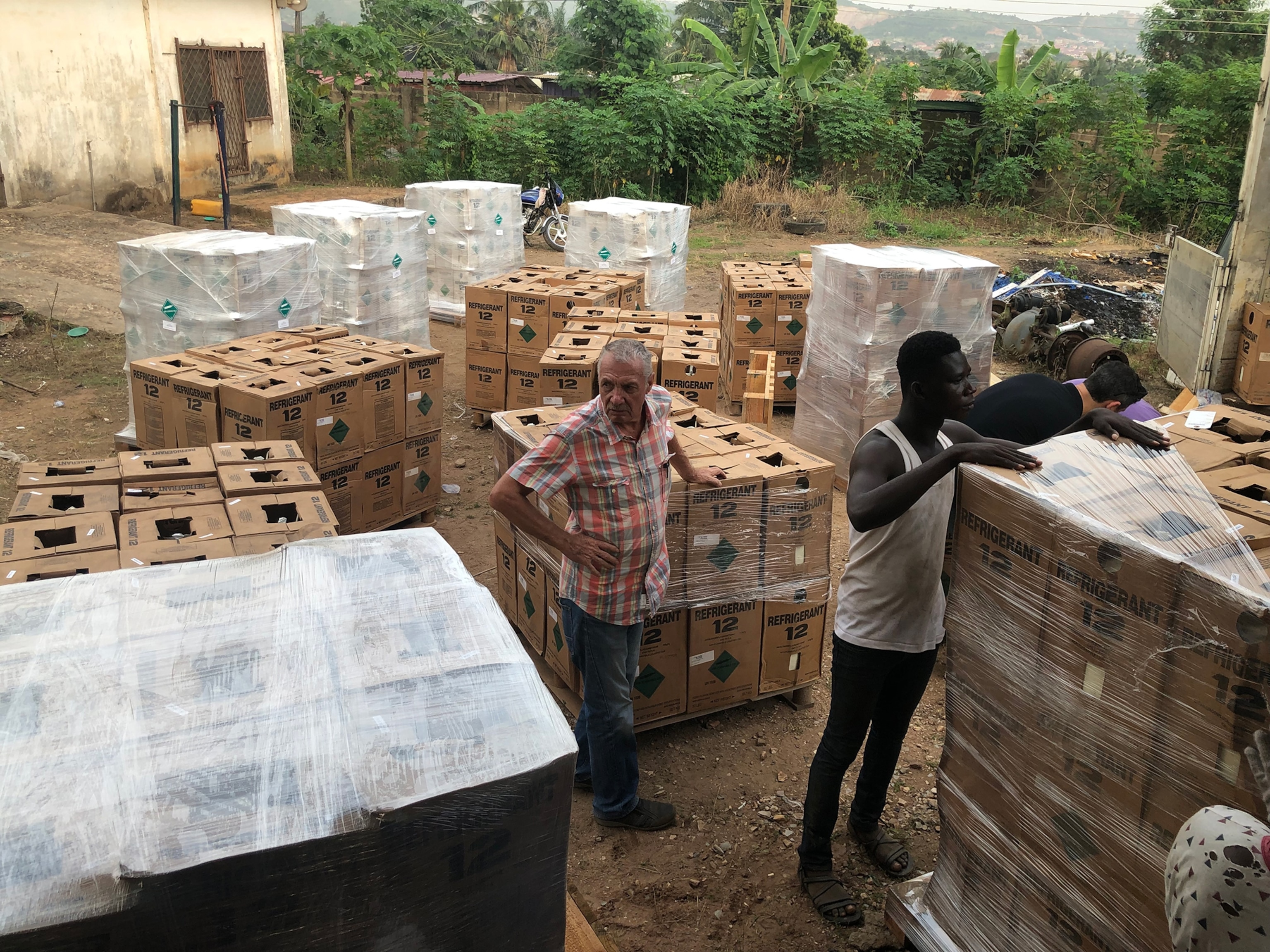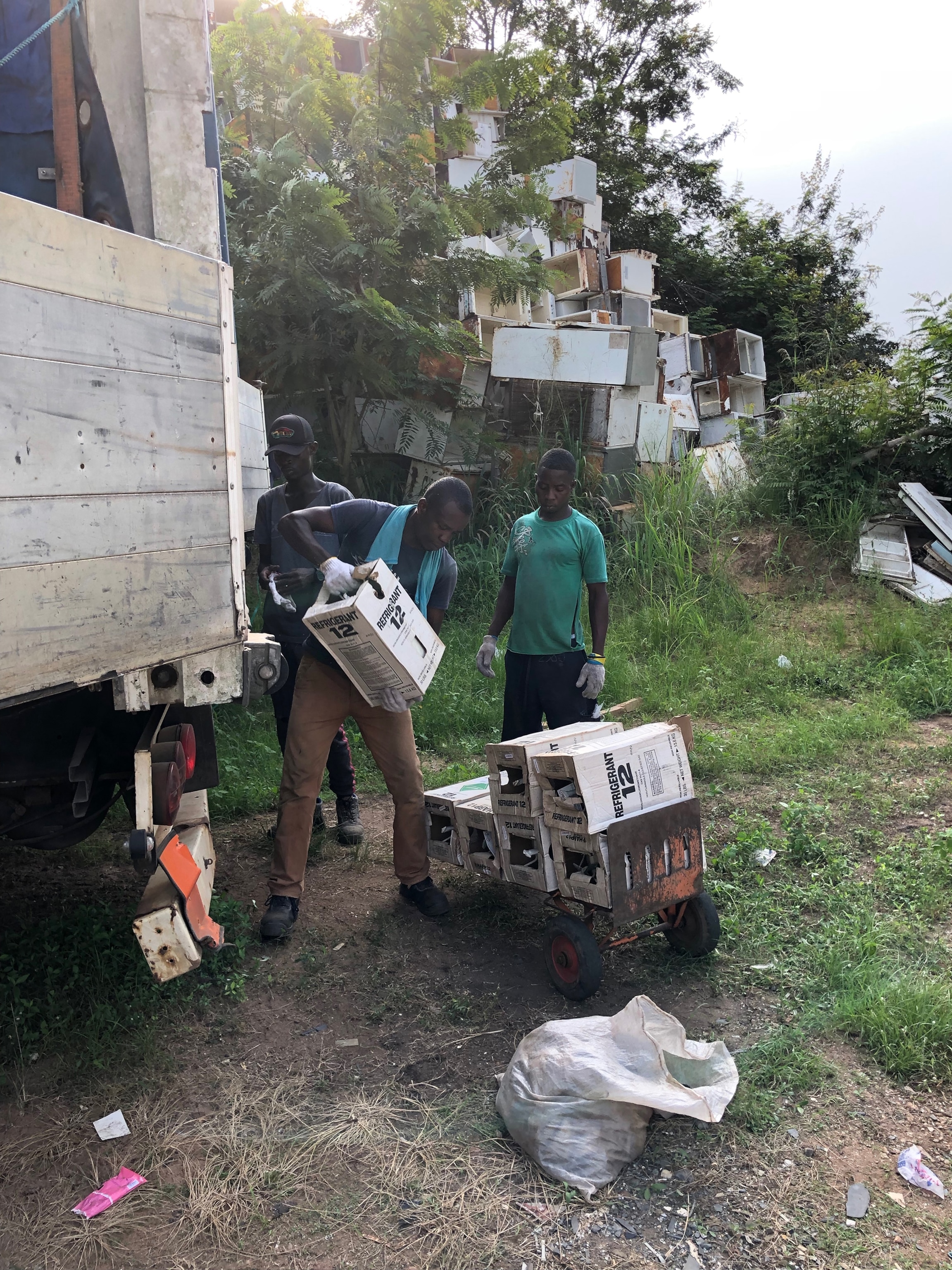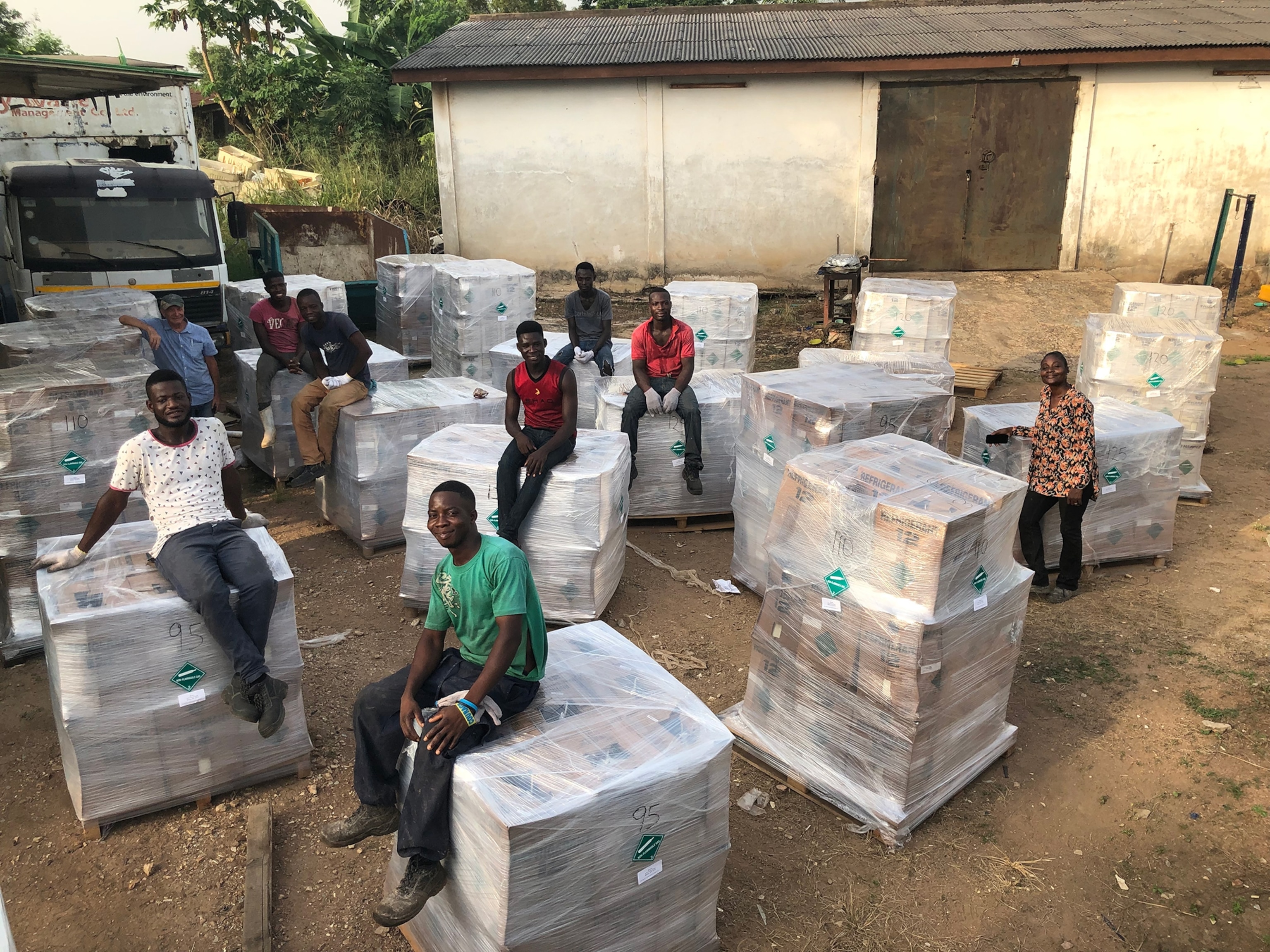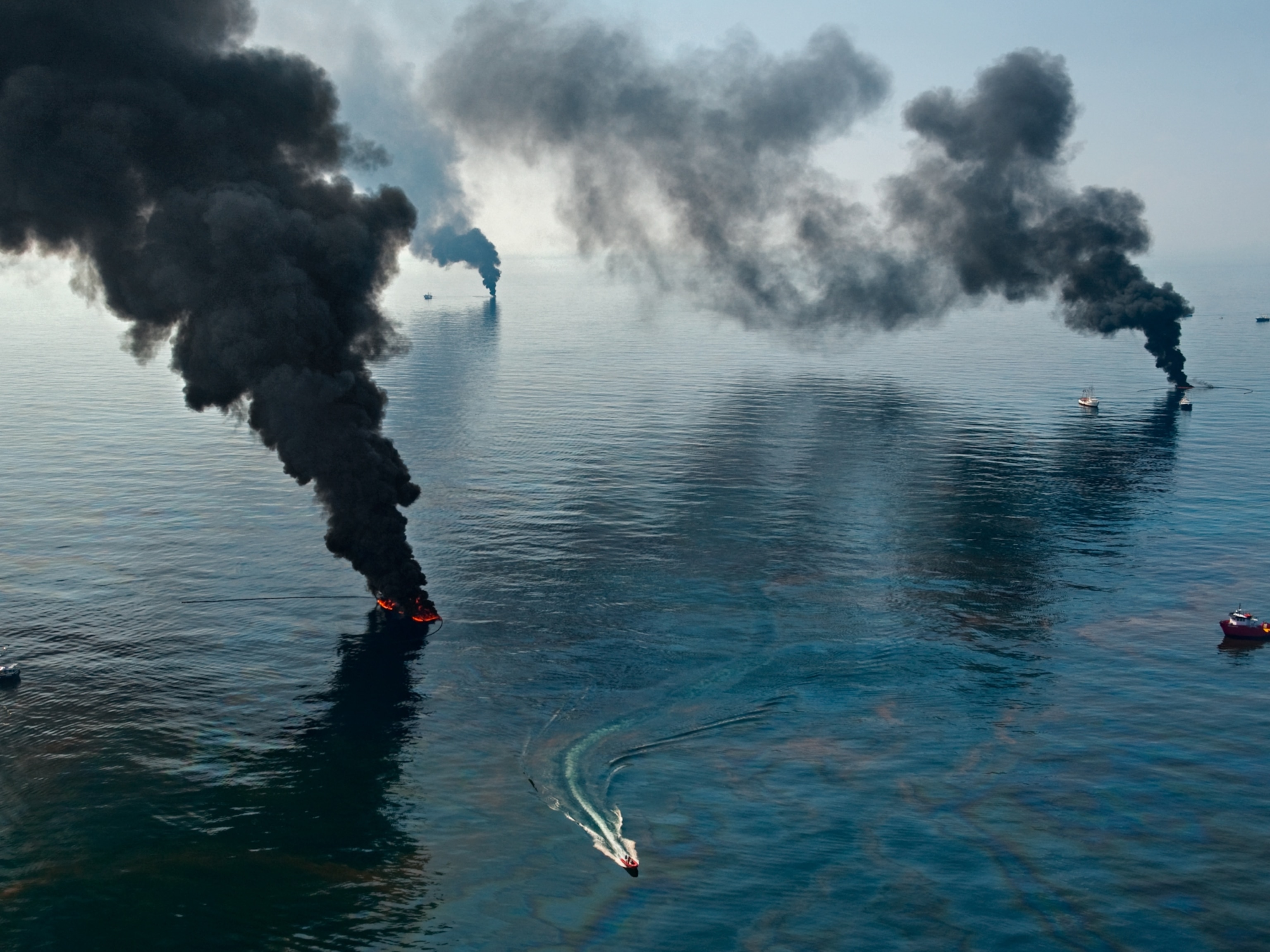
One overlooked way to fight climate change? Dispose of old CFCs.
The banned refrigerants not only degrade ozone, they act as greenhouse gases. New models are making it easier to get rid of old stocks.
At City Waste Recycling in Accra, Ghana, owners Jürgen Meniel and Vivian Ahiayibor mostly focus on plastics and metals, but they also reclaim refrigerants from old equipment. Several years ago, they learned of a large cache of unused canisters of a refrigerant called CFC-12. The containers looked like small propane tanks, but the gas inside was illegal.
Outlawed thirty years ago by the Montreal Protocol because of their harmful effects on the stratospheric ozone layer, CFCs have also been found to have a second, destructive effect on the climate.
A single molecule of CFC-12 can hold nearly 11,000 times the heat of carbon dioxide, making it an extraordinarily potent greenhouse gas. The small, dark shed where the refrigerant cache was gathering dust held nearly 30,000 pounds of CFCs. If released into the atmosphere, those CFCs would hold the same heat as the carbon dioxide emissions from burning 16 million gallons of gasoline.
Last year, a coalition of scientists and policy experts at the nonprofit Drawdown ranked the top one hundred climate change solutions by level of impact. No one guessed that refrigerant management, which includes CFCs and two other classes of chemicals known as HCFCs and HFCs, would top the list. But it did.
The Drawdown study estimated that properly disposing of old refrigerants, rather than letting them leak into the air, would be equivalent to preventing nearly 90 gigatons of carbon dioxide from reaching the atmosphere. That’s more than 17 years of U.S. CO2 emissions.
“It’s an incredibly important solution,” said Chad Frishmann, Drawdown’s Research Director.
So the science is clear: cleaning up the world’s legacy CFCs would help prevent additional greenhouse gases from further changing the climate. Yet actually doing this, particularly in developing countries, is still being worked out, thanks to financial and logistical challenges. Still, a new wave of entrepreneurs think they have found solutions that work both for the climate and companies.
What was left in the bank
The Montreal Protocol, which controls the release of refrigerants into the atmosphere, is heralded as one of the most successful environmental treaties, in part because of the speed and unanimity with which the nations of the world responded to the threat to the ozone layer. Within just four years of the discovery of the thinning ozone hole, the agreement was in force.
But the Montreal Protocol is also important because of what it did for the climate. Ozone-depleting gases turned out to be potent greenhouse gases. The Montreal Protocol is estimated to have prevented the equivalent of 10 gigatons of CO2 per year from reaching the atmosphere, or about a quarter of the world’s annual carbon dioxide emissions. There’s no doubt that if not for the Montreal Protocol, climate change would already be much more dire.

But in order to achieve consensus, negotiators of the Montreal Protocol had to be forward-looking. The nations of the world agreed to ban future production of ozone-depleting chemicals but quantities of ozone-depleting gases that already existed, materials that have come to be known as “banks,” were left out of the agreement. The banks weren’t insignificant either. In 1988, the year before the protocol went into effect, the size of the CFC bank was slightly more than that year’s global emissions of CO2.
Today those CFC banks have decreased in size; most of the gas has already leached into the atmosphere. The majority of today’s refrigerant bank is a chemical class known as HFCs. Its production was recently banned in the Kigali Amendment to the Montreal Protocol in October 2016. If the world holds to the agreement, the Kigali Amendment is set to avoid nearly a degree Fahrenheit temperature increase by the end of the century. Disposing of the bank properly could do even more.
Because there’s no requirement for tracking them, getting a handle on the size of older CFC banks includes some modeling. Estimates are based on historical inventories of equipment that contains refrigerants. Unused canisters of CFCs, like the ones in the shed in Ghana, are probably not included in those models since they were never put into equipment. That means that the banks of refrigerants—even as large as they are—are an underestimate of what’s out there.
Finding—and funding—a solution
By phone from Accra, City Waste Recycling’s Meniel explained that when he found the canisters in the shed, he knew they couldn’t be sold because “CFCs are banned everywhere.” Yet, the canisters full of CFCs were like a slowly rusting climate bomb. Something had to be done. “Otherwise, it will stay there forever, and eventually escape into the atmosphere.”
There’s no technical hurdle to overcome to dispose of CFCs. The gas can be incinerated in special kilns, breaking the molecules into a benign mixture. But with no disposal facilities in all of Ghana, indeed all of West Africa, the problem is financial. Without the weight of a regulation like the Montreal Protocol, who’s going to foot the bill?
Chicago entrepreneurs Tim Brown and Gabe Plotkin believe the answer lies with the private sector. They work at Tradewater, a company that develops projects that reduce greenhouse gas emissions. Their business model is based on being able to sell those reductions as carbon offset credits on carbon markets.
In California, the cap-and-trade market buys and sells such carbon credits. However, for a CFC disposal project to qualify in California, the CFCs must be sourced domestically. That rule is one reason why most of the CFCs in the U.S. have already been destroyed, but a project to dispose of CFCs from Ghana can’t be sold in California’s market. So, Plotkin and Brown turned to the voluntary carbon market.
The voluntary carbon market is where individuals and corporations go to buy carbon offsets, not because they are required to, but because they choose to meet personal or internal goals for carbon neutrality. Offset projects on the voluntary market range from wind farms in Asia to reforestation in South America to clean cookstove projects in Africa.
“The voluntary carbon market really is an innovator,” said Saskia Feast, vice president at Natural Capital Partners, a company that works with large corporations like Microsoft and the media company Sky, to achieve their sustainability goals. The money that corporations feed in to the voluntary market makes it possible for entrepreneurs like Brown and Plotkin to develop projects to reduce greenhouse gases that might not otherwise happen.
While the voluntary market encourages creative business solutions to climate change problems, there’s also risk. According to a 2017 report by Ecosystem Marketplace, which tracks trends in environmental finance, “it’s a buyer’s market—almost as many offsets remain unsold as sold.”
To see if the voluntary market would support a CFC destruction project, Tradewater’s Brown and Plotkin ran a pilot test. They bought a small portion of the City Waste’s CFCs and contracted a third party verifier to certify the contents and document the destruction of the CFCs inside under a rigorous protocol called the Verified Carbon Standard. The project generated nearly 20,000 carbon credits, the equivalent of preventing 20,000 tons of carbon dioxide from entering the atmosphere. Tradewater offered the credits on the voluntary market, and waited for a buyer.
Spurring a new market
A buyer arrived in the software company Intuit, known for its TurboTax and QuickBooks products. Sean Kinghorn is the company’s senior sustainability program manager, responsible for setting the strategy for Intuit’s environmental footprint. That includes offsetting all carbon emissions from fuel burned at their facilities to electricity to turn on the lights to emissions from employees’ commutes. Even by that expansive measure, Intuit has been carbon neutral since 2015. One way they achieve their neutrality goals is through the voluntary market.
"Renewable energy is fantastic, but it gets all the press,” said Kinghorn. “We need dozens and dozens of different types of solutions. So, this is absolutely critical.
He explained that Tradewater’s CFC project resonated with Intuit because they were aware of the overlooked problem of refrigerant management. “It’s a carbon offset, but it’s also spurring a new market somewhere where it’s needed. Hopefully it makes a difference.”

It already has. Because of the sale, Tradewater was able to return to Ghana last December. Over the course of two days, Brown and Plotkin removed the remaining 771 cylinders from that dark shed, packing them onto 24 pallets. The pallets were loaded onto a ship to cross the Atlantic. They arrived at the Port of Houston in February and were aggregated the CFCs into one tank and shipped by truck to East Liverpool, Ohio, where they were destroyed in April. The process generated over 130,00 carbon credits and averted the equivalent of a year’s emissions from 27,601 cars from reaching the atmosphere.
If the market supports this second project, Brown and Plotkin will likely return to Ghana. Meniel says there are more CFCs to be collected. “There’s still more in the system. We are still trying to sweep up in Ghana and then go to neighboring countries. Yes, because there’s plenty.”
The story doesn’t end there. Curious about working with Costa Rica’s carbon market, Brown and Plotkin traveled to San Jose, where they discovered more unused cylinders of CFCs. That work in Costa Rica led them to look in Colombia, and they will head to Argentina in May.
"We are gearing up to go after this stuff as much as we can,” Plotkin said. “We know that this material is out there and we know we have the ability to go find it and collect it and destroy it. We can’t turn away from it. It's not going to happen but for that market. It’s an essential part of the equation.”








